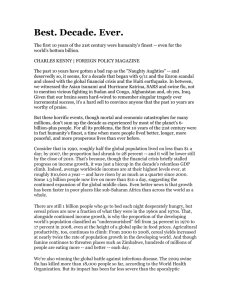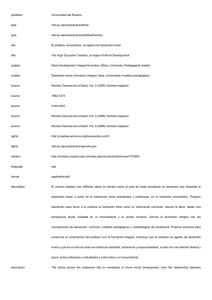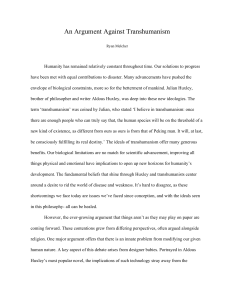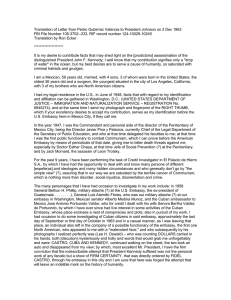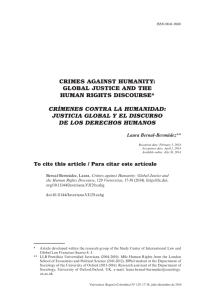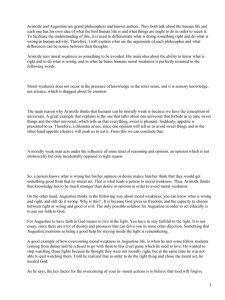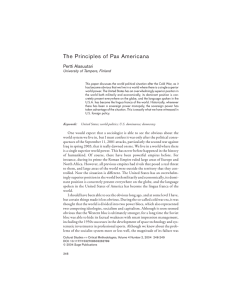Who believes that identification with all humanity is ethical
Anuncio
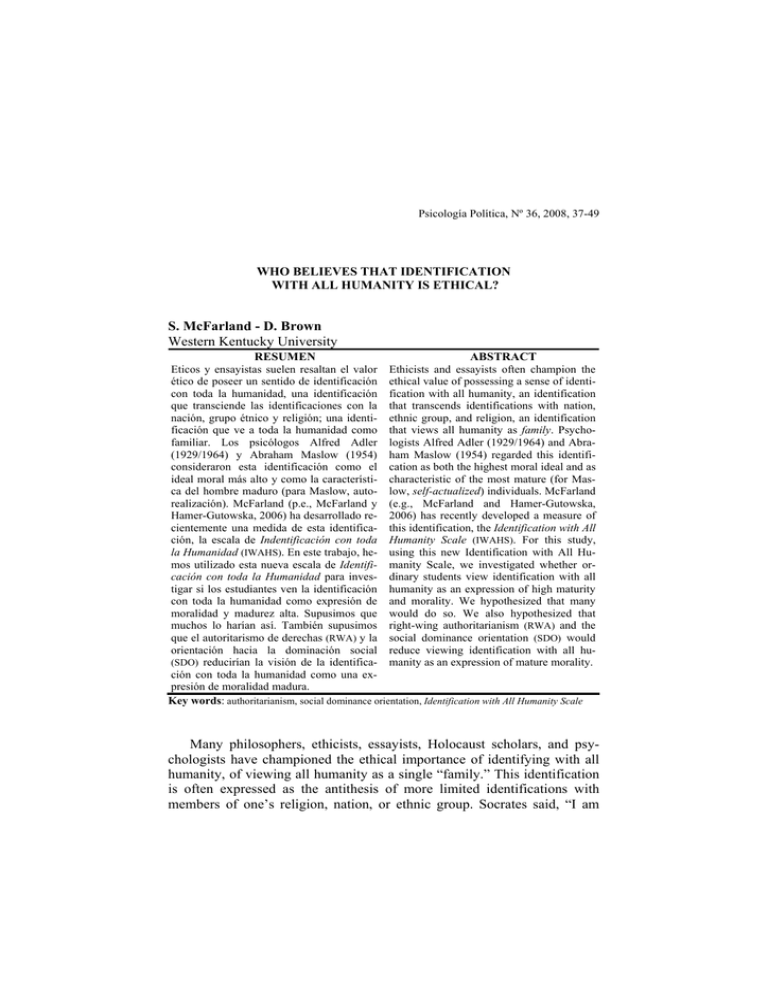
Psicología Política, Nº 36, 2008, 37-49 WHO BELIEVES THAT IDENTIFICATION WITH ALL HUMANITY IS ETHICAL? S. McFarland - D. Brown Western Kentucky University RESUMEN ABSTRACT Eticos y ensayistas suelen resaltan el valor Ethicists and essayists often champion the ético de poseer un sentido de identificación ethical value of possessing a sense of identicon toda la humanidad, una identificación fication with all humanity, an identification que transciende las identificaciones con la that transcends identifications with nation, nación, grupo étnico y religión; una identi- ethnic group, and religion, an identification ficación que ve a toda la humanidad como that views all humanity as family. Psychofamiliar. Los psicólogos Alfred Adler logists Alfred Adler (1929/1964) and Abra(1929/1964) y Abraham Maslow (1954) ham Maslow (1954) regarded this identificonsideraron esta identificación como el cation as both the highest moral ideal and as ideal moral más alto y como la característi- characteristic of the most mature (for Masca del hombre maduro (para Maslow, auto- low, self-actualized) individuals. McFarland realización). McFarland (p.e., McFarland y (e.g., McFarland and Hamer-Gutowska, Hamer-Gutowska, 2006) ha desarrollado re- 2006) has recently developed a measure of cientemente una medida de esta identifica- this identification, the Identification with All ción, la escala de Indentificación con toda Humanity Scale (IWAHS). For this study, la Humanidad (IWAHS). En este trabajo, he- using this new Identification with All Humos utilizado esta nueva escala de Identifi- manity Scale, we investigated whether orcación con toda la Humanidad para inves- dinary students view identification with all tigar si los estudiantes ven la identificación humanity as an expression of high maturity con toda la humanidad como expresión de and morality. We hypothesized that many moralidad y madurez alta. Supusimos que would do so. We also hypothesized that muchos lo harían así. También supusimos right-wing authoritarianism (RWA) and the que el autoritarismo de derechas (RWA) y la social dominance orientation (SDO) would orientación hacia la dominación social reduce viewing identification with all hu(SDO) reducirían la visión de la identifica- manity as an expression of mature morality. ción con toda la humanidad como una expresión de moralidad madura. Key words: authoritarianism, social dominance orientation, Identification with All Humanity Scale Many philosophers, ethicists, essayists, Holocaust scholars, and psychologists have championed the ethical importance of identifying with all humanity, of viewing all humanity as a single “family.” This identification is often expressed as the antithesis of more limited identifications with members of one’s religion, nation, or ethnic group. Socrates said, “I am 38 Psicología Política, Nº 36, Mayo 2008 neither Athenian nor Greek, but a citizen of the world.” William Lloyd Garrison said, “My country is the world. My countrymen are mankind.” Einstein urged us to “remember your humanity, and forget the rest.” Gandhi said, “All humanity is one undivided and indivisible family, and each one of us is responsible for the misdeeds of all the others. I cannot detach myself from the wickedest soul.” Self-identified American radical Saul Alinsky said, “Who is a radical? He is that person who . . . is so completely identified with humankind that he personally shares the pain, the injustices, and the sufferings of all his fellow humans.” In the early 1950s, when Edward Steichen created his classic photographic essay The Family of Man, he did so to oppose the rampant cold-war nationalism and ethnocentrism of the times and to create an opposite vision of, as he said, “the essential oneness of mankind” (Steichen, 1955, p. 4). To psychologists Adler (1929/1964) and Maslow (1954), identifying with all humanity -an identification that transcends identifications with nation, ethnic group, and religion- both represents the highest moral ideal and is characteristic of the most mature (self-actualized) individuals. Adler’s (1927/1954) concept of social interest, a translation of the German word gemeinschaftsgefuhl, refers to a genuine caring for the well-being of others, and its most mature meaning refers to a sense of “oneness with humanity” (Adler, 1954, p. 38). One who possesses mature social interest embraces the whole human community, regardless of race, nationality or any other distinction. A person with mature social interest acts “in the interests of mankind generally,” rather than just in the interest of one’s community, ethnic group or nation, and one engages in activities that are aimed at “helpfulness to all mankind, present and future” (Adler, 1929/1964, p. 78). Mature social interest extends even for unborn generations. To Abraham Maslow (1954), one of the central qualities of the most mature or self-actualized individuals is that they exhibit human kinship. They possess, Maslow wrote, “a deep feeling of identification, sympathy, and affection for human beings in general . . . [a] feeling of identification with mankind” (p. 138). They are psychologically “members at large of the human species” (p. 145) rather than just members of a particular group or nation. They have, Maslow says, “a genuine desire to help the human race” (p. 138). For the past three years, the first author of this paper (McFarland) has been developing and testing an operational measure of this identification, called the Identification with All Humanity Scale (IWAHS). None of the five existing measures of social interest (Crandall, 1980; Curlette, Wheeler, & Kern, 1997; Greever, Tseng, & Friedland, 1973; Sulliman, 1973; Whee- Who believes that identification with all humanity is ... 39 ler, Kern, & Curlette, 1982) and neither of the two measures of selfactualization (Jones & Crandall, 1986; Shostrom, 1964) actually tap this identification directly. One might think that identification with all humanity is simply the opposite of ethnocentrism, and could be adequately assessed as low scores on a measure of ethnocentrism. However, this is not the case. While ethnocentrism and identification with all humanity are consistently negatively correlated, one could be free of all ethnocentrism and still care little for the well-being of humanity. Identification with all humanity represents a positive caring, a genuine concern and love for all other members of the human family, a regarding of all other human beings as a part of one’s ingroup. Measuring Identification with All Humanity With some missteps along the way, the Identification with All Humanity Scale (IWAHS) now consists of nine three-part items in the form of the following items: 1. How much do you identify with (that is, feel a part of, feel love toward, have concern for) each of the following? a. People in my community b. Americans c. All humans everywhere 2. When they are in need, how much do you want to help: a. People in my community b. Americans c. People all over the world We have used a five-point response scale ranging from 1 (e.g., not at all) to 5 (e.g., very much) The full scale is presented in the Appendix. When administered in other countries, that country's name may be substituted for Americans. Because the three are presented together, a comparison is implicitly suggested but not explicitly requested. However, this simultaneous presentation doesn’t appear to matter, for when the three types of items (People in my community, Americans, and People all over the world) are each presented in bundles separated from the others, the scale and measurement model (described below) function just as well. Also, earlier studies included identification with one’s family and ethnic group, but these were found to be unnecessary, serving only to make the assessment quite a bit longer while not enhancing validity. For most samples, the mean 40 Psicología Política, Nº 36, Mayo 2008 identification with all humanity is about half a point lower on the five-point scale for each item. The Measurement Model. Three IWAHS scores can be derived from this scale. The raw score is merely the sum of the nine items asking about identification with all humanity. However, the raw score has two problems. From the beginning, raw scores on identification with all humanity have correlated substantially with raw scores on the other identifications, usually between .4 and .6. This degree of overlap means that the raw score assessing identification with people all over the world is contaminated quite a bit with other identifications. In studies in both the United States and Poland, we have found that the raw score correlates with help given to people in one’s community, but only because it correlated with identification with people in one’s community; identification with people all over the world, statistically controlling for identification with people in one’s community, did not predict this community assistance (McFarland & HammerGutowska, 2006). Also, the raw score is confounded slightly with Paulhus’s (1984) two indices of social desirability, impression management and self-deception, as are the raw scores of identification with community and Americans. What is needed is a score that eliminates the variance associate with identification with one’s community and nation, and with social desirability. A second possible score is an ipsative score. The ipsative score is defined as the sum of the differences between the identification with all humanity score on each item and the mean of the responses to the other groups (community and America) on the same item. The ipsative measure has the advantage of reflecting the importance one gives to identification with humanity in comparison to identification with the other groups. Also, because it is also socially desirable to identify closely with one’s community and nation, ipsative scoring should eliminate, or at least greatly reduce, correlations with social desirability. Even if not driven by social desirability, all identifications have comparable wording and an identical response format, so ipsative scoring should control for this common method variance. Ipsative scores, like the raw scores, have alphas across samples of about .85 However, ipsative scoring is also problematic. Ipsative scores are difference scores, and do not reveal whether an individual receives a high score because he or she is high in identification with all humanity or merely low in identifying with one’s community and nation. An individual who answered 2 to all three identifications (i.e. this person identifies just a little, but equally, with members of their community, nation, and all humanity) Who believes that identification with all humanity is ... 41 would receive an ipsative score of 1 [2 - ((2+2)/2) = 0], but so would an individual who answered 5 (very much) to all identifications [5 - ((5 + 5)/2) = 0]. Clearly, the latter individual is expressing a stronger identification with all humanity. Because the vast majority of respondents (about 85%) identify more with members of their community and nation than with all humanity, most ipsitive scores are in the negative range. A third possibility -and the one eventually chosen- is to regress the raw scores of identification with all humanity onto identification with one’s community and identification with Americans and use the residual as the measure of identification with all humanity. This process gives higher weighting to higher raw scores, social desirability is likely reduced, and one is left with the variance in identification with all humanity that is specific to that identification. Correlations with the residual scores are essentially part correlations, with variance associated with the identification with community and nation removed from the predictor, the IWAHS, but not from the dependent measure. Which of these three measures is best can be tested by the pattern of correlations with social desirability and other variables with which identification with all humanity logically correlates. Logically, identification with all humanity should correlate positively with concern for international human rights and other global issues such as world hunger, and should correlate negatively with ethnocentrism. Table 1, using data from the first study in this series, a sample of 200 college students, presents the correlations of the raw score, ipsative score, and standardized scores with ethnocentrism, priority given to human rights, a measure of global concerns, and Paulhus’s (1988) two measures of social desirability (impression management and self-deception). Table 1 Correlations of IWAHS raw scores, ipsative scores, and residual scores with ethnocentrism, priority of human rights, global concerns, and two measures of social desirability (impression management and self-deception). Ethnocentrism Human Rights Humanitarian Concerns Impression Management SelfDeception Raw score -.29 .25 .26 .25 .07 Ipsative score -.35 .39 .40 .03 -.18 Residual -.39 .42 .41 .09 -.10 score Note: Correlations greater than .18 are significant at p < .05; correlations above .25 are significant at p < .001. 42 Psicología Política, Nº 36, Mayo 2008 The pattern of correlations in Table 1 -which is consistent with most later data- is that the standardized residual appears to be the strongest measure of identification with all humanity. It has the largest positive correlations with human rights and global humanitarian concerns, the largest negative correlation with ethnocentrism, and unlike the raw score and ipsative score, it is not significantly correlated with either impression management or self-deception. Do Students See Identification with All Humanity as Ethical? As cited earlier, many ethicists and other notable figures, along with psychologists Adler and Maslow, regard identification with all humanity to be the most psychologically mature and most ethical perspective. But what about ordinary students and others? For this study, we investigated whether ordinary students view identification with all humanity as an expression of high maturity and morality. Assuming that many do so, we also examined whether two important individual differences influence who does, and who does not, regard identification with all humanity as the mature and moral ideal. We hypothesized that right-wing authoritarianism (RWA; Altemeyer, 1996) and the social dominance orientation (SDO; Sidanius and Pratto, 1999), labeled the lethal union (Altemeyer, 1998) because of their many combined effects upon ethnocentric attitudes, would reduce the likelihood of regarding identification with all humanity as an expression of mature morality. Previous studies have shown that RWA and SDO correlate negatively with identification with all humanity; perhaps individuals high on RWA and SDO, unlike others, simply do not think a mature and moral person would do so. Right-wing authoritarianism is associated with a moralistic ethnocentrism, a belief in the moral superiority of the ingroup and the moral inferiority of outgroups (Altemeyer, 1988), and with a strong belief in the importance of loyalty to the ingroup (Duckitt, 1988). For these reasons, it seems likely that authoritarianism would moderate the likelihood of viewing identification with all humanity as the moral ideal. The social dominance orientation is associated with a competitive, individualistic, dog-eat-dog view of human relationships. Individuals high in social dominance see the world as everyone for oneself, apparently rightfully so. Little has been reported on the moral ideals of high SDO individuals, although the SDO itself shows that they are low on the ideal of equality. Wilson (2003) found that social dominance reduced idealism, specifically reducing the concern that one’s actions might harm others. McFarland Who believes that identification with all humanity is ... 43 (2005) found that a main reason that the social dominance orientation was associated with support for attacking Iraq was that social dominance reduced concern for the suffering that the attack might cause. Given this evidence, it seems likely that social dominance will reduce the likelihood of viewing identification with all humanity as what a fully mature and moral person would do. Method Students (N = 367) ranging from freshmen through graduate students first completed the RWA, SDO and the IWAHS. They were then asked to “imagine the most mature and most moral person you could imagine anyone being” and to complete the IWAHS a second time “as you believe the most moral and most mature person you could imagine would answer” (the words in bold were printed that way on the questionnaire). Participants were reminded of this instruction at the top of each page of the questionnaire. The questionnaire, which took less than thirty minutes to complete, was administered in classes across campus with the permission of the professor of each class. The final sample was 85% Caucasian and 68% female. Between 18% and 26% were representative of each undergraduate class, and 9% were graduate students. Results As anticipated, many in the sample believed that identifying with all humanity is what a very mature and moral person would do, even while they did not do so themselves. Fully 86% of the participants felt that the most fully mature and most moral person they could imagine would identify more strongly with humanity than they personally reported doing; that is, the participant’s IWAHS scores for how such a person would respond were higher than their personal scores for 86% of the sample. The individuals’ own raw score item mean on the IWAHS was 3.03 (almost exactly somewhat on the five-point scale) in their identification with people all over the world. Just 7% of this sample averaged 4.0 (quite a bit) in their personal identification with people all over the world. However, the participants’ mean perception of how a moral and most mature person would respond averaged 4.03 (almost exactly quite a bit on the five-point scale), and 45% of the sample thought that a fully mature and moral individual would identify with people all over the world quite a bit to very much. The responses to one item were typical: Whereas only 13% said that they personally very much (5 on the 5 point response scale) “feel a part of, feel love 44 Psicología Política, Nº 36, Mayo 2008 toward, have concern for all humans everywhere,” when asked to respond as the most mature and moral person they could imagine would respond, 47% felt that a mature and moral person would very much (5 on the 5 point response scale) do so. Moderating Effects of Authoritarianism and Social Dominance This result was moderated by authoritarianism and the social dominance orientation, as these correlated -.21 and -.20, p < .01, in each case with the ideal IWAHS. As in previous studies, RWA and SDO also each correlated negatively, -.33, p < .01 in each case, with the individuals’ own IWAHS scores. In summary, not only do RWA and SDO reduce identification with all humanity, both reduce the belief that a mature and moral individual would do so. There was also a tendency for students in higher level college classes to believe more strongly than lower class students that a fully mature and moral person would identify with all humanity, r = .13, p < .05. Gender had no effect upon how strongly students believed that a mature and moral person would identify with all humanity. A backward regression was conducted on the ideal IWAHS scores entering SDO, RWA, class in school, and gender. These results are presented in Table 2. The first three variables each contributed to ideal IWAHS scores, whereas gender did not. Table 2 Backward Regression of RWA, SDO, and Demographic Variables upon “Mature and Moral” IWAHS. B SE B b Social Dominance Orientation -.013 .005 -.17a Right-Wing Authoritarianism -.015 .007 -.13b .07 .04 .10c Class in School R = .27; R2 = .07. Superscripts a, b, and designate significance levels of p < .01 and p < .05, and p < .10, respectively. Discussion Our students are not moral philosophers, and probably few of them have ever articulated that one should think of all humanity as family, that this is what a mature and moral person would do. Nevertheless, when asked, the vast majority of them apparently implicitly think that one should, even though they recognize that they may not do so themselves. Who believes that identification with all humanity is ... 45 These effects were moderated by social dominance and authoritarianism, both of which reduced the likelihood of regarding identifying with all humanity as the mature and moral perspective. However, while these effects were significant, they were weak, accounting for just 7% in the variance in responses to the ideal IWAHS. This research leaves two main questions yet to be answered. The principal question that this study leaves open is why most students, when asked do, believe that fully moral and mature individuals would identify strongly with all humanity? Are they taught it? If so, why do they not identify with all humanity themselves? At first glance, our finding -that most individuals intuitively recognized that moral and mature individuals will identify with all humanity, even if they, themselves, did not- seems compatible with Haidt’s (2001, 2007) recent emphasis upon the power of moral intuitions. Haidt has found that humans possess moral intuitions that frequently precede, shape, and may also override moral reasoning. However, our finding also differs from Haidt’s in two ways. First, Haidt has emphasized emotional intuitions that guide judgments of right and wrong (e.g., the deep feeling that it is wrong to eat one’s dead pet), even when one knows that he or she cannot offer a logical reason for the moral judgment. In contrast, the belief that one should identify with all humanity appears intuitively compelling when presented, but not emotionally driven in the same way as in Haidt’s work. Second, Haidt’s work describes moral feelings that his participants both possess and claim. In our findings, however, our respondents intuitively recognized a morality that persons who were more moral and mature would possess, even though they, themselves did not. In short, our results suggest another category of moral intuitions in addition to the emotionally driven intuitions described by Haidt. This issue is worthy of further study. We suggest that the knowledge that a moral person would identify with all humanity is, for the majority of individuals, implicit, inherently logical, requiring only that the question be framed to recognize its truth. Merely facing the question brings attention to the fact that more limited identifications are artificial, necessarily limited in their nature. And perhaps merely facing the question is sufficient to inspire many to realize that identifying with all humanity is the moral ideal, perhaps one they should adopt as their own. Nevertheless, our findings suggest that this would be less effective for those who are high in social dominance and/or authoritarianism because these individuals are less likely to agree that identifying with all humanity is the moral ideal. A second issue, then, is why do authoritarianism and 46 Psicología Política, Nº 36, Mayo 2008 social dominance lead to less belief that identification with all humanity is a moral ideal? Social dominance is strongly related to seeing the world as competitive, dog-eat-dog, and this view appears to be accepted as the norm for human behavior (e.g., Sibley, Wilson & Duckitt, 2007). Perhaps the social dominance orientation is not just associated with believing the world is competitive and dog-eat-dog, but believing that is the way the world ideally should be. Authoritarianism, on the other hand, appears to be largely driven by seeing the world as a dangerous place (e.g., Winter, 1996; Sibley et al., 2007). This perceived dangerousness enhances loyalty to one’s ingroup. In all likelihood, it also strengthens a belief in the importance of ingroup loyalty as morally more important than identifying with all humanity. In summary, then, it seems likely that the effects of social dominance and authoritarianism in reducing belief that identification with all humanity represents the moral ideal are consistent with their effects on other ethnocentric attitudes. The competitive world view of the socially dominant individual, and the dangerous world view of the authoritarian person, are likely the factors that mediate their rejection of identification with all humanity as a moral ideal. References Adler, A. (1954): Understanding human nature. (Wolfe, W. B., Trans.) Greenwich, Conn.: Fawcett Publications (Original work published 1927). Adler, A. (1964): Problems of neurosis. New York: Harper Torchbooks (Original work published in 1929). Altemeyer, B. (1988): Enemies of freedom. San Francisco: Jossey-Bass. Altemeyer, B. (1996): The authoritarian specter. Cambridge, MA.: Harvard University Press. Altemeyer, B. (1998): The other “Authoritarian Personality.” In M. P. Zanna (Ed.), Advances in Experimental Social Psychology, Vol. 30. New York: Academic Press. Crandall, J. E. (1980): Adler’s concept of social interest: Theory, measurement, and implications for adjustment. Journal of Personality and Social Psychology, 39, 481-495. Curlette, W. L., Wheeler, M. S., & Kern, R. M. (1997): BASIS-A inventory technical manual. Highlands, NC: TRT Associates. Duckitt, J. (1988): Authoritarianism and group identification: A new view of an old construct. Political Psychology, 10, 63-84. Greever, K. B., Tseng, M. S., & Friedland, B. U. (1973): Development of the Social Interest Index. Journal of Consulting & Clinical Psychology, 41, 454-458. Haidt, J. (2001): The emotional dog and its rational tail: A social intuitionist approach to moral judgment. Psychological Review, 108, 814-834. Who believes that identification with all humanity is ... 47 Haidt, J. (2007): The new synthesis in moral psychology. Science, 316, 998-1002. Jones, A., & Crandall, R. (1986): Validation of a short index of self-actualization. Personality and Social Psychology Bulletin, 12, 63-73. Maslow, A. H. (1954): Motivation and personality. New York: Harper & Row. McFarland, S. G. (2005): On the eve of war: Authoritarianism, social dominance, and American students' support for attacking Iraq. Personality and Social Psychology Bulletin, 31, 360-367. McFarland, S., & Hamer-Gutowska, K. (2006): All Humanity is my Ingroup: A Measure and Studies of "Identification with all Humanity." Unpublished Paper. Paulhus, D. L. (1984): Two-component models of socially desirable responding. Journal of Personality and Social Psychology, 46, 598-609. Shostrom, E. L. (1964): An inventory for the measurement of self-actualization. Educational and Psychological Measurement, 24, 207-218. Sibley, C. G., Wilson, M. S., & Duckitt, J. (2007): Effects of dangerous and competitive worldviews on right-wing authoritarianism and social dominance orientation over a five-month period. Political Psychology, 28, 357-371. Sidanius, J., & Pratto, F. (1999): Social Dominance. New York: Cambridge University Press. Steichen, E. (1955): The Family of Man: The photographic exhibition created by Edward Steichen for the Museum of Modern Art. New York: Simon and Schuster. Sulliman, J. R. (1973): The development of a scale for the measurement of social interest. Dissertation Abstracts International, 34(06), 2914B. Wheeler, M. S., Kern, R. M., & Curlette, W. L. (1982): Wheeler-Kern-Curlette LifeStyle Personality Inventory. Unpublished inventory. Wilson, M. S. (2003): Social dominance and ethical ideology: The end justifies the means? Journal of Social Psychology, 143, 549-558. Winter, D. (1996): Personality: Analysis and Interpretation of Lives. New York: McGraw Hill. Sam McFarland, is a professor in the Department of Psychology of the Western Kentucky University and member of the same one from 1971. Joint author of Courageous Resistance: The Power of Ordinary People, published in 2007 by McMillan. Among his lines of research we highlight: human rights, the authoritarian personality, prejudice and ethnocentrism, psychology of the religion. ([email protected]). Derek Brown is graduate student in the department of Psychology in Western Kentucky University. Address: Sam McFarland. Department of Psychology. Western Kentucky University.1906 College Heights Blvd. Bowling Green, KY 42101. USA 48 Psicología Política, Nº 36, Mayo 2008 Appendix* Identification with All Humanity Scale (IWAHS) 1. How close do you feel to each of the following groups? 1 = not at all close 2= not very close 3 = just a little or somewhat close 4 = pretty close 5 = very close a. People in my community b. Americans c. People all over the world 2. How often do you use the word “we” to refer to the following groups of people? 1 = almost never 2 = rarely 3 = occasionally 4 = often 5 = very often a. People in my community b. Americans c. People all over the world 3. How much would you say you have in common with the following groups? 1 = almost nothing in common 2 = little in common 3 = some in common 4 = quite a bit in common 5 = very much in common a. People in my community b. Americans c. People all over the world Please answer all remaining questions using the following choices: 1 = not at all 2 = just a little 3 = somewhat 4 = quite a bit 5 = very much Who believes that identification with all humanity is ... 49 4. Sometimes people think of those who are not a part of their immediate family as “family.” To what degree do you think of the following groups of people as “family?” a. People in my community b. Americans c. All humans everywhere 5. How much do you identify with (that is, feel a part of, feel love toward, have concern for) each of the following? a. People in my community b. Americans c. All humans everywhere 6. How much would you say you care (feel upset, want to help) when bad things happens to a. People in my community. b. Americans. c. People anywhere in the world. 7. How much do you want to be: a. a responsible citizen of your community. b. a responsible American citizen. c. a responsible citizen of the world. 8. How much do you believe in: a. being loyal to my community. b. being loyal to America. c. being loyal to all mankind. 9. When they are in need, how much do you want to help: a. people in my community. b. Americans. c. people all over the world. *Note: When administered in other countries, that country's name may be substituted for "Americans."

